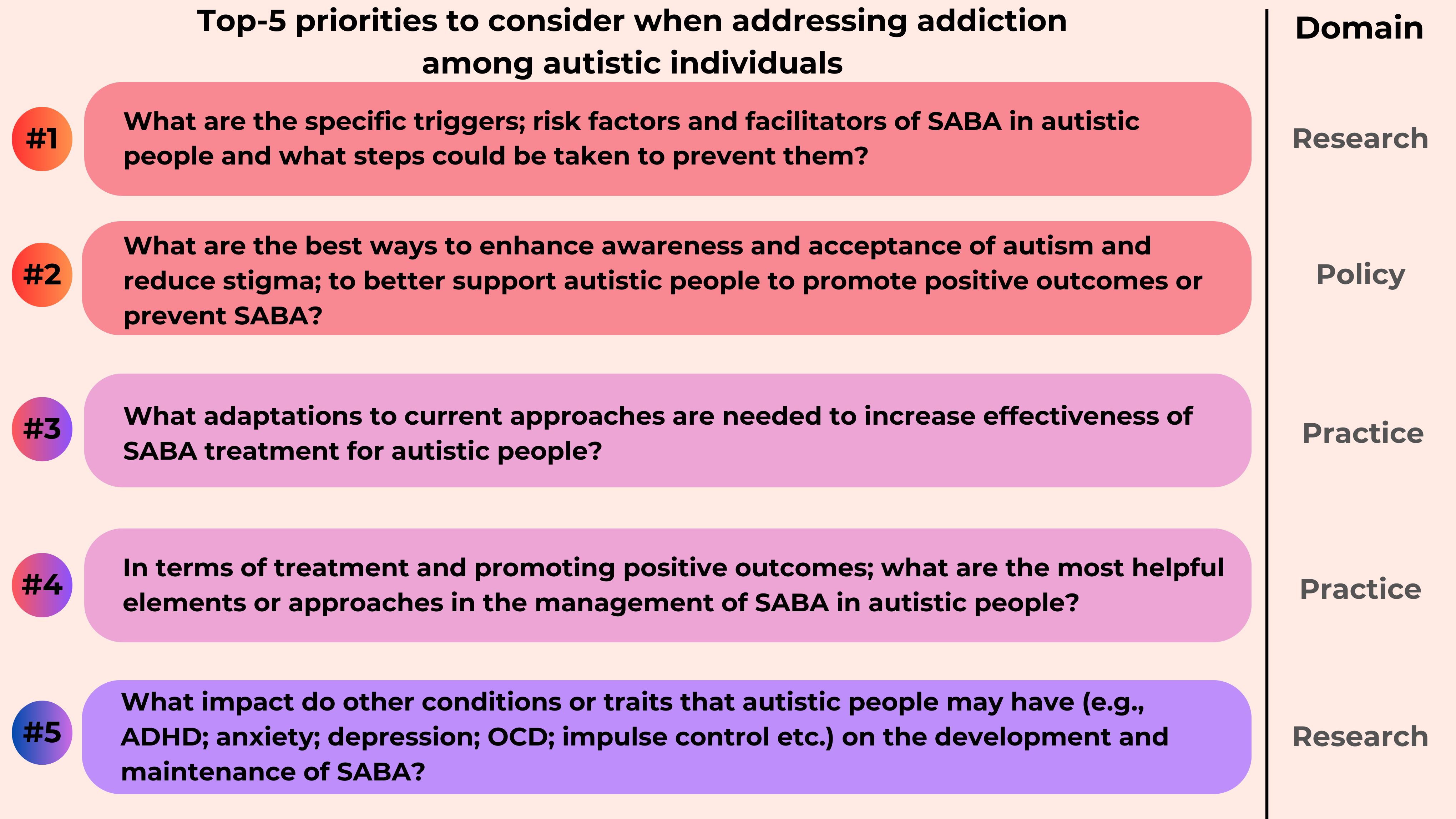Autistic people1 are at higher risk for experiencing challenges related to substance use, alcohol use, and gambling compared to the general population. While some contradictory findings regarding these associations exist, autistic people may turn to substances as a way of coping with social anxiety and adapting to challenging life situations. Unfortunately, there is limited research addressing the intersection between autism and addictive disorders, impeding the development of effective interventions or health policies. This week, STASH reviews a study by Julia M.A. Sinclair and colleagues that identified essential substance use, alcohol, and behavioral addiction (SABA) priorities that policymakers, researchers, and practitioners should focus on when addressing addiction-related concerns in autistic individuals.
What was the research question?
What are the essential SABA priorities that policymakers, researchers, and practitioners should focus on when addressing addiction-related concerns in autistic individuals?
What did the researchers do?
The researchers used a Priority Setting Partnership procedure to identify policy, research, and clinical practice priorities, pertaining to the intersection of autism and addiction. The researchers assembled a diverse, international steering committee of 10 members, including people with lived experience with autism and/or addiction, autism experts, and addiction researchers. This committee conducted a comprehensive literature review, focusing on SABA in autistic individuals, and generated key questions for future research. To gain additional perspectives, the researchers shared these questions via an online survey at various workshops, where 68 more participants contributed their own questions. After omitting any irrelevant or duplicate questions, 22 participants, who contributed to the development of these questions, participated in an online consensus process, classifying and ranking the questions based on domain (i.e., policy, research, or clinical practice) and level of importance. They generated 340 total questions that met the researchers’ criteria and identified the 10 most important.
What did they find?
The number one priority for addressing SABA in autistic individuals concerns research (see Figure). Specifically, experts called for more research to understand the triggers, risk factors, and protective factors for SABA in autistic individuals. Another research priority was exploring the impact of co-occurring conditions like ADHD and OCD on addictive behavior. In the policy domain, it is important to address stigma and ableism by promoting awareness and acceptance of autism, especially those living with addiction or marginalized in another way. Another policy priority was adapting screening/assessment tools to more effectively diagnose and treat autistic people with SABA and other co-occurring disorders. In the practice domain, there is a need to adapt current approaches for use among autistic individuals and provide training to substance use disorder treatment providers who are working with autistic individuals.

Figure. The Figure depicts the top-5 priorities for addressing addiction among autistic individuals, ranked from 1 (highest priority) to 5. These priorities are categorized based on their specific domain for the guidance of policymakers, researchers, and practitioners. This Figure was adapted from Sinclair et al. (2023). Click image to enlarge.
Why do these findings matter?
These findings address a lack of knowledge surrounding autism and addiction. Prioritizing SABA research allows for a more comprehensive understanding of prevalence rates, risk factors, and protective factors. This research will inform policies aimed at tailored interventions, stigma reduction, and enhanced healthcare training. Clinicians working with this population should educate themselves on the unique needs and challenges faced by autistic individuals, and customize their treatment approaches accordingly. For example, autistic people might benefit from extended therapy sessions and greater collaboration between family and local professionals as a part of their treatment plan. In essence, this collective effort involving policy, research, and practice is essential to effectively addressing addiction and autism, all while empowering individuals to lead healthier, more autonomous lives.
Every study has limitations. What are the limitations in this study?
The study sample was relatively small, and the findings have the potential for bias due to the manual selection of the top priorities. Future work should involve larger expert panels and alternative methodological approaches, such as factor analysis, and should begin to test the feasibility, acceptability, and effectiveness of the proposed interventions and policies.
For more information:
If you are worried that you or someone you know is experiencing addiction, the SAMHSA National Helpline is a free treatment and information service available 24/7. For more details about addiction, visit our Addiction Resources page.
— Nakita Sconsoni, MSW
What do you think? Please use the comment link below to provide feedback on this article.
________________
1. Though there is no universally accepted way to refer to autistic people, the general preference of many in the autistic community is to use identity-first language, so that is the language we will be using in this review.




